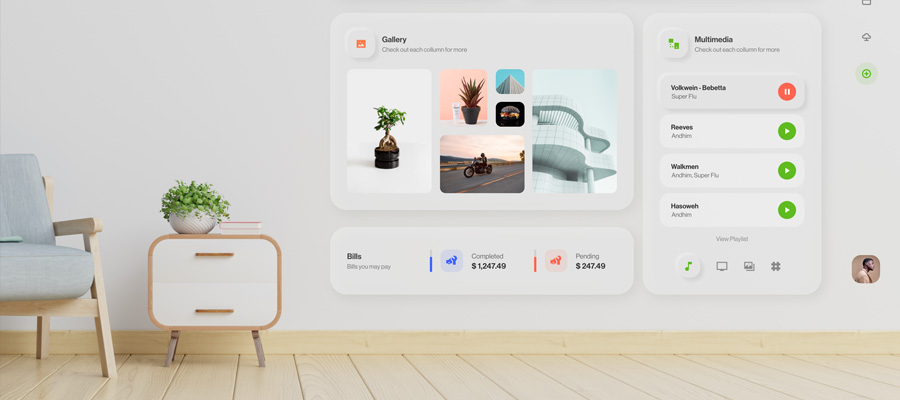In the 21st century, a computer monitor is no longer a tool that lets you visualize software. When choosing one, you pay attention to the quality of the image you see and, of course, the level of comfort you get.
Over recent decades, digital technologies have made some dramatic advances, and, thus an ordinary CRT monitor is no longer suitable for home use.
Aside from their main function, modern monitors can display video clips and pictures by adjusting to individual customer preferences. However, the majority of people do not even have a clue about their monitor’s characteristics and just pay attention to “attractive” numbers, such as the size, price, and year of manufacture.

Typography Design Report by Maxime Bourgeois
Today, we will discuss some of the most popular myths about monitors.Hopefully, our article will help you make a more informed choice before purchasing one.
#1 The Lower Response Time The Better
Response rate is the amount of time a monitor takes to process a signal. In other words, this is a time during which a monitor refreshes the picture you see. For example, whenever you type some words on your keyboard, you experience a very short delay between your computer processing this action and displaying it. However, you will never notice it because response rate is measured in milliseconds and cannot be detected by the human eye.
Indeed, the lower response rate, the better. If you work with a monitor with a response rate of 30 ms and more, you will notice annoying delays. Moreover, it will adversely affect your eyes. Usually, you see the world without any “delay” because your eyes are adjusted to the real-time picture. Thus, using a monitor with high response rate is bad for your eyes.
On the other hand, lower response time does not mean better performance. According to the PubHub.com, the human eye will not detect any changes if response rate is lower than 10 ms. Thus, if you want to buy a monitor will a response rate of, let’s say, 8 ms, you will just waste your money and not notice any increase in performance.
#2 A Bigger Monitor Size Means a Better Picture
Everybody likes big screens. People like watching movies or playing video games on wide screens. Allegedly, the size of a monitor is the most valuable characteristic. But this is only partially true — the size of a monitor only matters if it matches a specific resolution. Thus, buying an enormous monitor with a low resolution will be a big mistake.
The majority of modern monitors have 1080p screens (1920x1080). However, if you’re considering buying a 27-inch monitor, you might experience severe pixelation. It happens because the size of the monitor is not enough to ensure a smooth picture with the available number of pixels.
Thus, if you want to buy a monitor sized between 27 and 32 inches, you should look for a QWXGA resolution (2048x1152). Usually, these monitors are perfect for gaming and can be used for routine tasks, such as typing texts, processing data or looking for a custom writing service.
If you want to watch movies in 4K, you should think about getting a 3840×2160 monitor. Besides the size, having several screens at once increases your multitasking skills.
#3 Does Contrast Ratio Matter?
When you are in an electronics store, you usually read the technical characteristics of a product before making a purchase. One of them is contrast ratio — an important feature which is frequently dismissed by the average buyer.
Contrast ratio helps users distinguish between black and white colors and luminance. In other words, it determines the brightness of colors, thus making white look even whiter and black even blacker. However, you should test several monitors to see the difference. It is a good idea to ask a shop assistant to play the same movie on several monitors before purchasing one. In this case, you will see the difference in contrast.
Unfortunately, the contrast ratio indicated on the monitor’s box is only a marketing feature meant to attract customers. It includes big numbers which influence people’s choice when they buy electronics. If you want to purchase a monitor consciously, you should bear in mind that this is just dynamic ratio. It means that the monitor can make some colors brighter by dimming others.
Monitors with a low dynamic ratio are very bad at displaying dark movie scenes and unlit places in video games. They darken the picture in order to make black look even blacker, thus darkening the objects that should be bright. You should, therefore, bring your own USB card with a short movie that has some dark scenes in it. By testing it on several monitors, you will see how well it performs and whether it is suitable for your eyes.
#4 You Should Buy A Monitor With a 120 Hz Refresh Rate
The last but not least is the refresh rate of a monitor. This is something you should also pay a lot of attention to. The majority of users do not realize the difference between 60 Hz and 120 Hz monitors until they compare both of them simultaneously.
If you want to check the difference on your own, you should visit a nearby electronics store and find two monitors with a different refresh rate. Preferably, both of them should be from the same brand and product line. Ask the consultant to play the same movie on them (you still have your USB stick with you, right?). You will immediately notice the difference because the picture will be smoother and more detailed on a 120 Hz monitor.
In order to dispel the myth about an adverse effect of high refresh rate, we should remember the time when it emerged. In the 1990s, CRT monitors with a refresh rate of more than 80 Hz caused a negative impact on human eyes. However, after the arrival of LCD and LED monitors, this problem disappeared.















